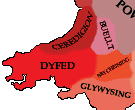
Click the Map to see
Dyfed's place in Britain
|
- Dyfed covers most of
South-East Wales. The name is pronounced 'Duv-ed'. It
developed from the name of the British tribe who lived there
from before the Romans arrived. They were called the 'Demetae'.
- Not long before the Romans
left Britain, they tried to protect themselves from Saxon
and Irish attacks by hiring
foreign mercenaries (soldiers). The ones who went to Dyfed
came from County Waterford in Ireland. Their tribe was called
the Déssi.
- Their Irish leader was
given the title of 'Protector'. We know this because the
gravestone of Protector Vortepor was found at the hillfort
of Castell Dwyran. The monk, Gildas, wrote a book
called the 'Ruin &
Conquest of Britain' in which
he called him a 'tyrant'.
- There was also a local
'king' of Dyfed. He was descended from the Roman Emperor
Magnus Maximus. In the Mid-5th century, the Protector married
the King's daughter. Their descendants ruled in Dyfed until
1197. That's over 800 years! The
English then took over. But the heirs of Dyfed remained
important lords in the area.
- Dyfed changed size and
name quite a lot. In the mid-7th century, it merged with
Brycheiniog. In the early 8th century, it lost Ystrad Towi and
was called Rhainwg. Then Brycheiniog split off again. In the
early 10th century, Dyfed merged with Seisyllwg (Ceredigion)
and became known as Deheubarth.
- The early Kings of Dyfed lived mostly at
Lis Castell (Lydstep) and nearby Din Bych (Tenby) and the
later ones at Dinefwr.
Their Royal monasteries were at
Llandeilo Fawr and St. Davids.
- Apart from Vortepor, the most famous Kings of
Dyfed were:
- Aergol
Lawhir - Vortepor's father who lived
in the late 5th century. He was friends with St. Teilo & St.
Oudoceus and helped
refugees from Brittany.
He fought a war against King Cynan
Gawyn of Powys.
- Hywel
Dda -
He lived in the early 10th century. He ruled Gwynedd
and Powys as well.
He was a very strong and powerful king. He was also
remembered as a good king who set out the first proper
Welsh Laws.
|

